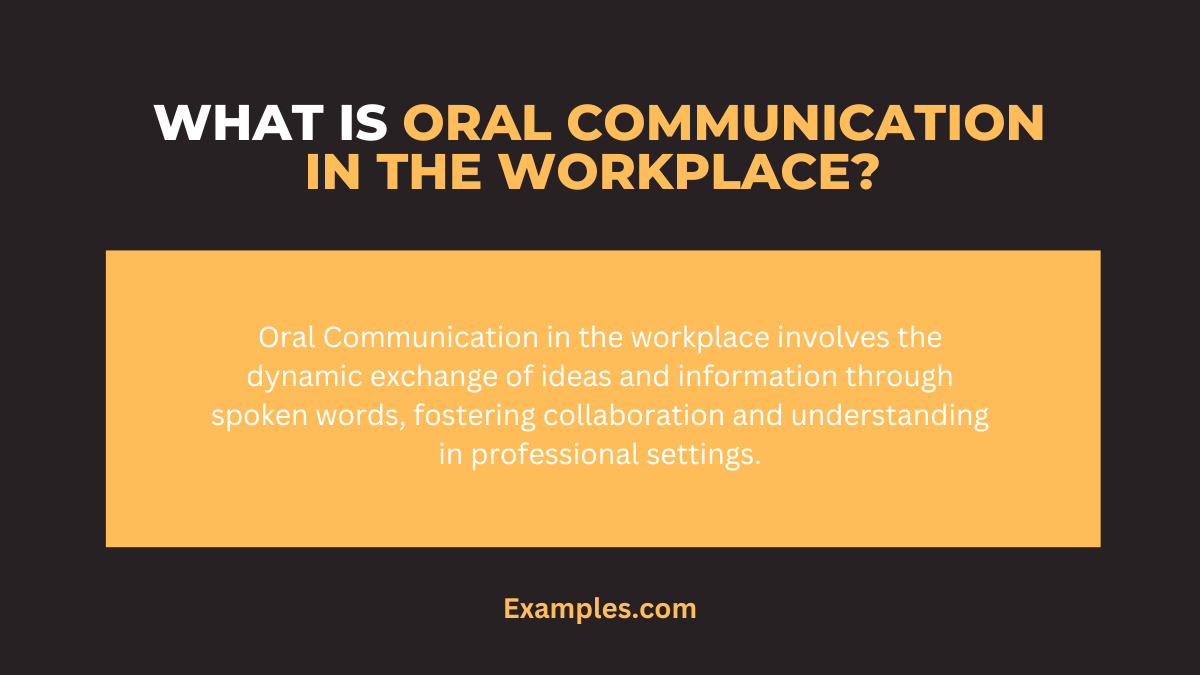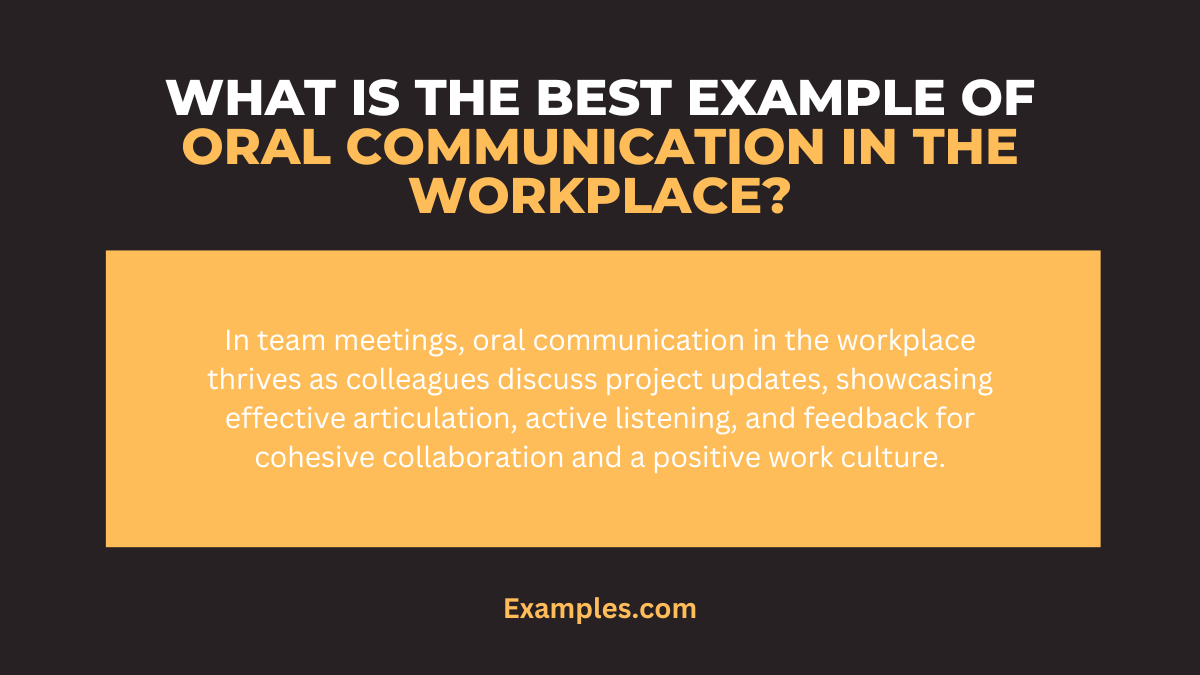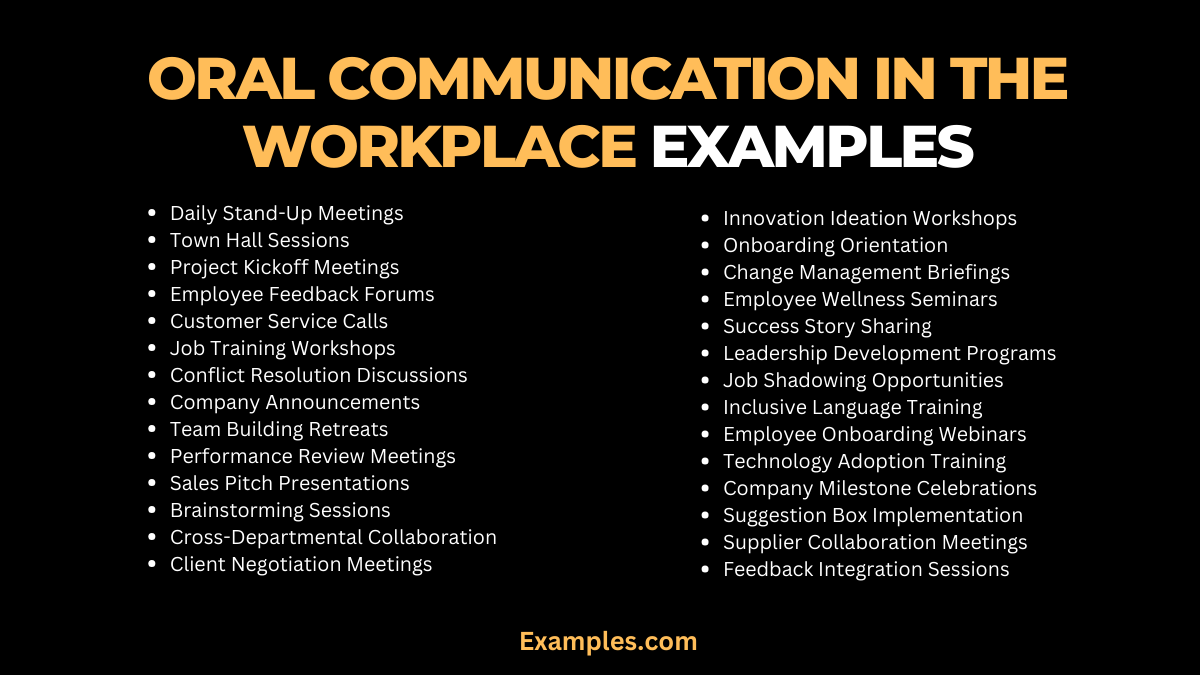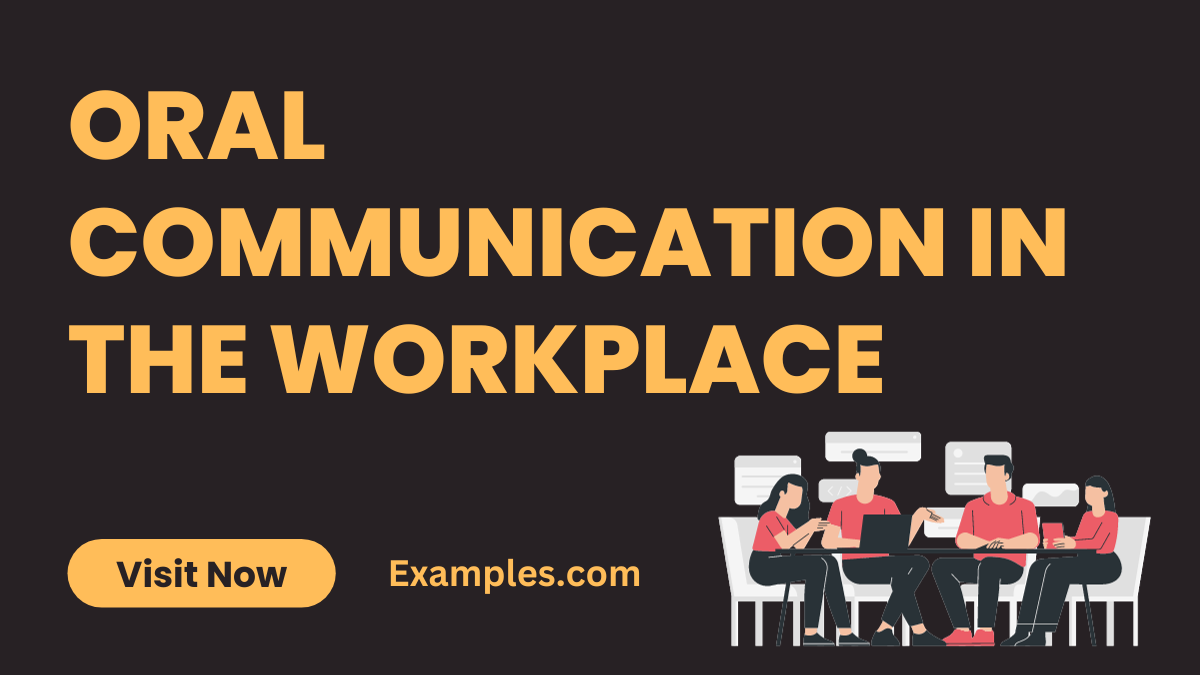29+ Oral Communication in the Workplace Examples
Unlock the power of effective Oral Communication in the Workplace with our comprehensive guide! Discover insightful examples illustrating how Communication Examples enrich professional interactions. From assertive communication to crisis management, we delve into diverse scenarios, providing strategies and tips for success. Elevate your career with a mastery of communication skills, exploring real-life workplace situations where effective oral communication is the key to success. Embrace a transformative journey toward enhanced collaboration and productivity through our curated Communication Examples.
What is Oral Communication in the Workplace?

Oral Communication in the workplace refers to the exchange of information, ideas, and messages through spoken words. It is a dynamic process where individuals convey thoughts verbally, fostering understanding and collaboration within professional settings. This form of communication encompasses face-to-face conversations, meetings, presentations, and other spoken interactions crucial for effective workplace dynamics.
What is the Best Example of Oral Communication in the Workplace?

A compelling example of oral communication in the workplace is a team meeting where colleagues discuss project updates. In this scenario, effective communication is demonstrated through clear articulation of ideas, active listening, and constructive feedback. The exchange of information during such meetings facilitates collaboration, ensures everyone is on the same page, and promotes a cohesive work environment. This example underscores the significance of oral communication in achieving organizational goals and fostering a positive workplace culture.
30 Oral Communication in the Workplace Examples

These examples showcase the versatility of oral communication in the workplace, covering diverse scenarios that contribute to organizational success and employee engagement.
- Daily Stand-Up Meetings:
- Conduct brief daily stand-up meetings for team members to share updates and align on tasks.
- Town Hall Sessions:
- Host town hall sessions for employees, promoting open dialogue on organizational matters.
- Project Kickoff Meetings:
- Initiate projects with comprehensive kickoff meetings to ensure team understanding and commitment.
- Employee Feedback Forums:
- Establish regular forums for employees to provide feedback, fostering a culture of continuous improvement.
- Customer Service Calls:
- Train customer service representatives to handle calls effectively, ensuring customer satisfaction.
- Job Training Workshops:
- Conduct job training workshops to enhance employee skills and knowledge through interactive sessions.
- Conflict Resolution Discussions:
- Address conflicts through open discussions, seeking resolutions and maintaining a positive work environment.
- Company Announcements:
- Disseminate important company updates through clear and concise announcements for staff awareness.
- Team Building Retreats:
- Organize team-building retreats with activities to enhance communication and collaboration.
- Performance Review Meetings:
- Conduct performance review meetings, providing constructive feedback for professional development.
- Sales Pitch Presentations:
- Train sales teams to deliver persuasive pitch presentations for effective client communication.
- Brainstorming Sessions:
- Hold regular brainstorming sessions to encourage creative thinking and idea generation within teams.
- Employee Recognition Ceremonies:
- Host ceremonies to recognize employee achievements, fostering a positive and appreciative workplace.
- Cross-Departmental Collaboration:
- Facilitate collaboration between departments through open communication channels and shared goals.
- Client Negotiation Meetings:
- Equip teams with negotiation skills for successful client meetings and agreement discussions.
- Crisis Management Talks:
- Prepare teams for crisis situations through informative talks and communication strategies.
- Innovation Ideation Workshops:
- Encourage innovation with ideation workshops, allowing employees to share and refine creative ideas.
- Onboarding Orientation:
- Provide comprehensive onboarding orientation for new employees to ensure a smooth integration process.
- Change Management Briefings:
- Communicate changes within the organization effectively through well-structured briefings.
- Employee Wellness Seminars:
- Promote employee well-being through wellness seminars, addressing physical and mental health.
- Success Story Sharing:
- Allow employees to share success stories, motivating others and fostering a positive work culture.
- Leadership Development Programs:
- Implement leadership development programs that emphasize effective communication skills for leaders.
- Job Shadowing Opportunities:
- Offer job shadowing opportunities to enhance cross-functional understanding and communication.
- Inclusive Language Training:
- Conduct training on inclusive language to ensure communication that respects diverse perspectives.
- Employee Onboarding Webinars:
- Utilize webinars for onboarding to provide information and foster communication with remote employees.
- Technology Adoption Training:
- Train employees on the adoption of new technologies, ensuring seamless integration and understanding.
- Company Milestone Celebrations:
- Celebrate company milestones with events that bring employees together, promoting camaraderie.
- Suggestion Box Implementation:
- Establish a suggestion box system to encourage employees to share ideas and feedback anonymously.
- Supplier Collaboration Meetings:
- Foster communication with suppliers through collaborative meetings for better partnerships.
- Feedback Integration Sessions:
- Integrate employee feedback into organizational processes, demonstrating a commitment to improvement.
Oral Communication in the Workplace for Interview
In a job interview, effective oral communication is crucial for conveying your skills and qualifications. Clear articulation, confident tone, and tailored responses help create a positive impression. Be attentive to nonverbal cues, maintaining eye contact to demonstrate engagement and sincerity.
- Elevator Pitch Delivery:
- Convey your professional strengths succinctly and confidently to make a memorable impact.
- STAR Method Application:
- Structure your responses using the Situation, Task, Action, and Result method for clarity and effectiveness.
- Handling Behavioral Questions:
- Address behavioral questions using real-life examples to showcase your skills and problem-solving abilities.
- Role-Play Scenarios:
- Practice role-play scenarios to enhance your adaptability and communication under different circumstances.
- Concise Self-Introduction:
- Craft a concise self-introduction that highlights your key qualifications and enthusiasm for the role.
- Asking Thoughtful Questions:
- Demonstrate engagement by asking thoughtful questions about the company culture and job responsibilities.
- Storytelling Technique:
- Utilize storytelling to narrate past experiences, making your responses memorable and impactful.
- Handling Panel Interviews:
- Address a panel with poise, directing responses to individual members while maintaining a holistic approach.
- Adapting to Virtual Interviews:
- Adjust your communication style for virtual interviews, focusing on clear articulation and maintaining a professional demeanor.
- Expressing Gratitude:
- Conclude the interview with a polite expression of gratitude, emphasizing your interest in the position.
Oral Communication in the Workplace for Resume
Effective oral communication extends to resume development, ensuring that your achievements are presented clearly. Tailor your resume to the job description, utilizing action verbs and quantifiable accomplishments. Create a compelling summary that sets the tone for your professional narrative.
Achievement-Oriented Bullet Points:
-
- Structure your resume with achievement-oriented bullet points to highlight specific contributions in each role.
- Skills Summary Section:
- Include a skills summary section, showcasing key competencies relevant to the desired job.
- Quantifiable Accomplishments:
- Quantify achievements to provide a tangible impact, such as increasing sales revenue or improving team efficiency.
- Tailored Job Descriptions:
- Customize job descriptions to align with the requirements of the target position, emphasizing relevant experiences.
- Professional Development Highlights:
- Highlight professional development, certifications, or courses that enhance your qualifications.
- Impactful Action Verbs:
- Use impactful action verbs to begin each bullet point, conveying a sense of accomplishment and action.
- Concise and Readable Format:
- Opt for a clean and readable resume format, ensuring that key information is easily accessible to recruiters.
- Strategic Use of Keywords:
- Integrate industry-specific keywords strategically to enhance your resume’s visibility in applicant tracking systems.
- Project Contributions Section:
- Create a section that outlines specific contributions to notable projects, showcasing your role and impact.
- Professional Endorsements:
- Incorporate professional endorsements or recommendations, adding credibility to your qualifications.
Crafting a resume with strong oral communication elements ensures that your professional narrative is compelling and resonates effectively with potential employers.
Oral Communication in the Workplace for Real Life
Oral communication in real-life workplace scenarios involves navigating everyday interactions crucial for collaboration and efficiency. It encompasses informal conversations, team discussions, and interpersonal connections that contribute to a positive work environment. Effective real-life communication fosters understanding, builds relationships, and promotes a culture of transparency.
- Coffee Break Chats:
- Use casual conversation during coffee breaks to build rapport and strengthen team relationships.
- Lunchtime Discussions:
- Engage colleagues during lunch to discuss non-work-related topics, creating a more relaxed and friendly atmosphere.
- Project Update Huddles:
- Conduct brief huddles to share project updates and foster real-time collaboration among team members.
- Remote Work Check-Ins:
- Schedule virtual check-ins to maintain connection and communication with remote team members.
- Feedback Sessions:
- Organize regular feedback sessions for constructive discussions on individual and team performance.
- Celebrating Achievements:
- Acknowledge and celebrate team achievements through verbal recognition and appreciation.
- Problem-Solving Meetings:
- Gather teams for collaborative problem-solving meetings, encouraging open dialogue and idea sharing.
- Employee Recognition Announcements:
- Share employee recognition announcements verbally to highlight accomplishments across the organization.
- Networking Events:
- Attend networking events to establish connections, exchange ideas, and promote the company positively.
- Mentorship Conversations:
- Facilitate mentorship conversations to provide guidance, share experiences, and promote professional development.
Why is Oral Communication Important in the Workplace?
Oral communication holds paramount significance in the workplace, serving as a cornerstone for effective interaction, collaboration, and overall organizational success. Several key reasons underscore the importance of oral communication in a professional setting.
- Fosters Clear Understanding:
- Importance: Oral communication ensures clarity in conveying complex ideas, instructions, and expectations, minimizing the risk of misunderstandings among team members and stakeholders.
- Promotes Efficient Collaboration:
- Importance: Collaborative projects and tasks thrive on effective communication. Oral communication facilitates real-time discussions, idea exchange, and prompt decision-making, fostering a collaborative work environment.
- Strengthens Team Dynamics:
- Building strong team relationships relies on open and clear communication. Oral communication contributes to team cohesion, trust, and a sense of shared purpose, enhancing overall team dynamics.
- Facilitates Timely Problem-Solving:
- Importance: Complex issues and challenges often require swift resolution. Oral communication enables team members to discuss problems, share insights, and collectively arrive at solutions in a timely manner.
- Enhances Leadership and Management:
- Importance: Effective leaders excel in oral communication. Whether addressing the team, conducting meetings, or providing feedback, strong oral communication skills are essential for leadership effectiveness.
- Supports Employee Engagement:
- Importance: Engaged employees are more likely to contribute positively to organizational goals. Oral communication, through regular updates, feedback sessions, and transparent dialogue, promotes higher employee engagement.
- Builds a Positive Work Culture:
- Importance: A positive work culture is cultivated through effective communication. Oral communication establishes an environment where ideas are valued, feedback is constructive, and inclusivity is prioritized.
- Ensures Client and Customer Satisfaction:
- Importance: For businesses, oral communication plays a crucial role in client interactions. Clear and articulate communication with clients ensures satisfaction, builds trust, and fosters long-term partnerships.
How can oral communication be improved in the workplace?
Oral communication is a cornerstone of workplace success, influencing collaboration, productivity, and team dynamics. Improving oral communication involves adopting strategies that enhance clarity, engagement, and understanding among team members. Here are key ways to elevate oral communication in the workplace:
1. Active Listening Techniques:
Foster a culture of active listening. Encourage team members to listen attentively, ask clarifying questions, and provide thoughtful responses. This ensures that information is accurately received and understood.
2. Clear Articulation:
Emphasize the importance of clear articulation. Encourage speakers to enunciate words, moderate their pace, and use appropriate pauses. Clear articulation minimizes misunderstandings and promotes effective communication.
3. Effective Body Language:
Train individuals to use positive body language. Non-verbal cues such as eye contact, gestures, and posture can convey confidence and sincerity, enhancing the overall impact of oral communication.
4. Structured Communication:
Advocate for structured communication. Encourage speakers to organize their thoughts before speaking, using a logical flow. This helps listeners follow the message more easily.
5. Encourage Questions:
Create an environment where asking questions is encouraged. This fosters a culture of curiosity and ensures that any uncertainties are addressed promptly, avoiding potential misunderstandings.
How to Create an Oral Communication in the Workplace?
Creating effective oral communication in the workplace requires a thoughtful approach that considers the context, audience, and desired outcomes. Follow these steps to craft impactful oral communication:
1. Define Objectives:
Clearly define the objectives of your communication. Understand what you want to achieve, whether it’s conveying information, inspiring action, or fostering collaboration.
2. Know Your Audience:
Tailor your communication to your audience. Consider their knowledge, preferences, and expectations to ensure your message resonates with them.
3. Craft a Clear Message:
Develop a clear and concise message. Avoid unnecessary jargon and complexity, focusing on delivering key points in a straightforward manner.
4. Consider the Medium:
Choose the appropriate communication medium. Whether it’s a face-to-face meeting, virtual presentation, or email, select the medium that aligns with your goals and audience.
5. Create an Engaging Structure:
Structure your communication for engagement. Organize your content logically, incorporating engaging elements such as anecdotes, examples, and visuals to maintain interest.
Tips for Effective Oral Communication in the Workplace?
Mastering effective oral communication is a valuable skill for professional success. Implement these practical tips to enhance your oral communication in the workplace:
1. Be Clear and Concise:
Express your thoughts in a clear and concise manner. Avoid unnecessary details and get straight to the point to maintain engagement.
2. Maintain Eye Contact:
Maintain appropriate eye contact during conversations. It conveys sincerity, confidence, and attentiveness, fostering a connection with your audience.
3. Mind Your Body Language:
Pay attention to your body language. Maintain open and confident posture, use gestures judiciously, and be mindful of facial expressions to complement your words.
4. Practice Active Listening:
Practice active listening. Demonstrate genuine interest in what others are saying, ask follow-up questions, and respond thoughtfully to contribute to meaningful conversations.
5. Adapt to Your Audience:
Adapt your communication style to your audience. Consider factors such as their knowledge level, cultural background, and preferences to tailor your approach.
The article on Oral Communication in the Workplace from Examples.com emphasizes the crucial role of oral communication skills in ensuring effective collaboration and organizational success. It highlights how these skills contribute to understanding, clarity, and a positive work culture, which are essential for cohesive teamwork and achieving shared goals in a dynamic workplace environment??.
To further enhance your understanding of oral communication in the workplace, consider exploring additional resources:
- Harvard Business Review (https://hbr.org This site offers valuable insights and research on communication dynamics in professional settings, focusing on how effective communication can transform workplace relationships and productivity.
- Toastmasters International (https://www.toastmasters.org As a renowned organization specializing in communication and leadership development, Toastmasters provides resources and training programs that can significantly improve oral communication skills in a variety of professional contexts.
By integrating knowledge from these high-authority sources, you can gain a comprehensive understanding of the nuances of oral communication and its impact on workplace dynamics. This multi-dimensional approach to learning will equip you with the skills and confidence to excel in professional communication scenarios.



